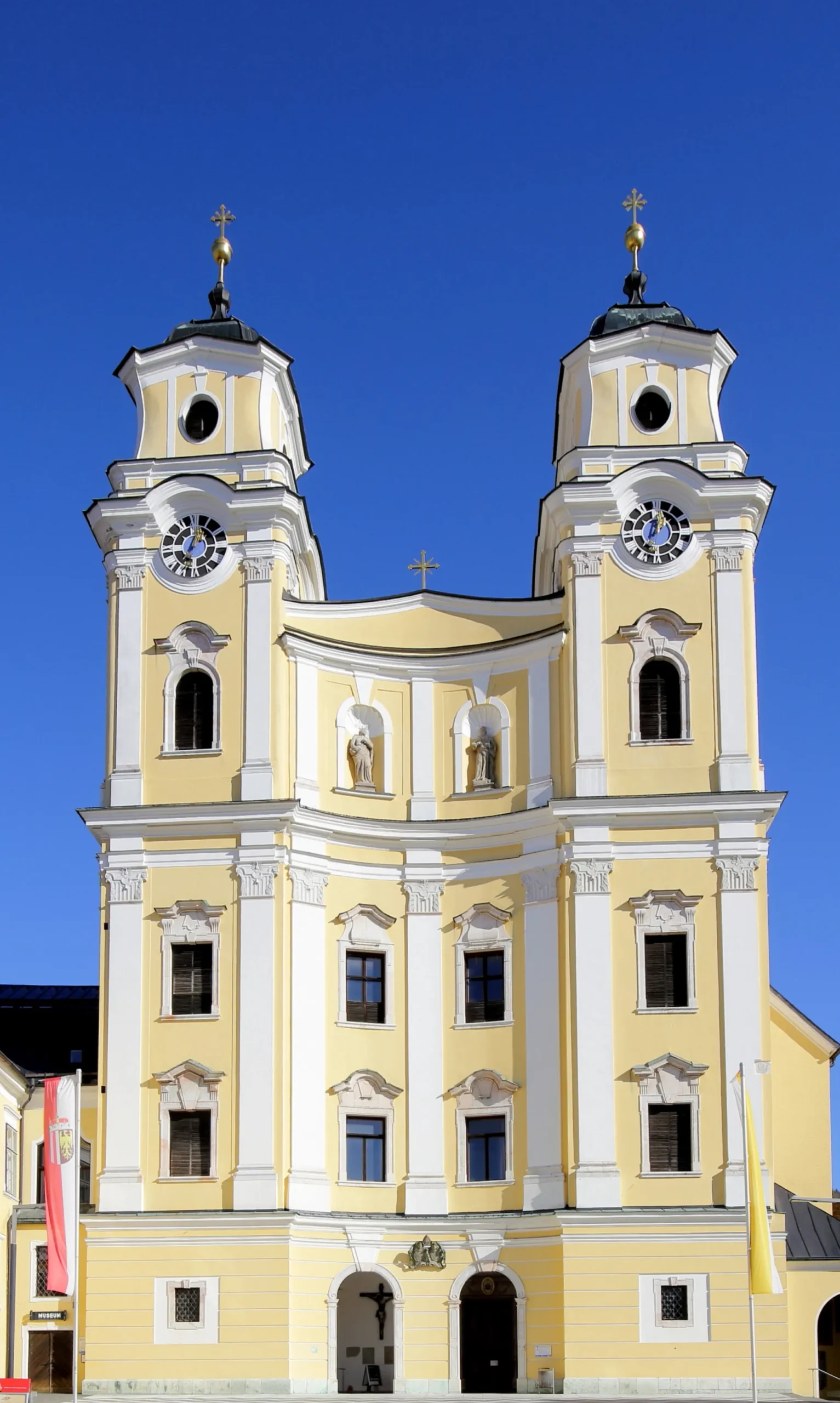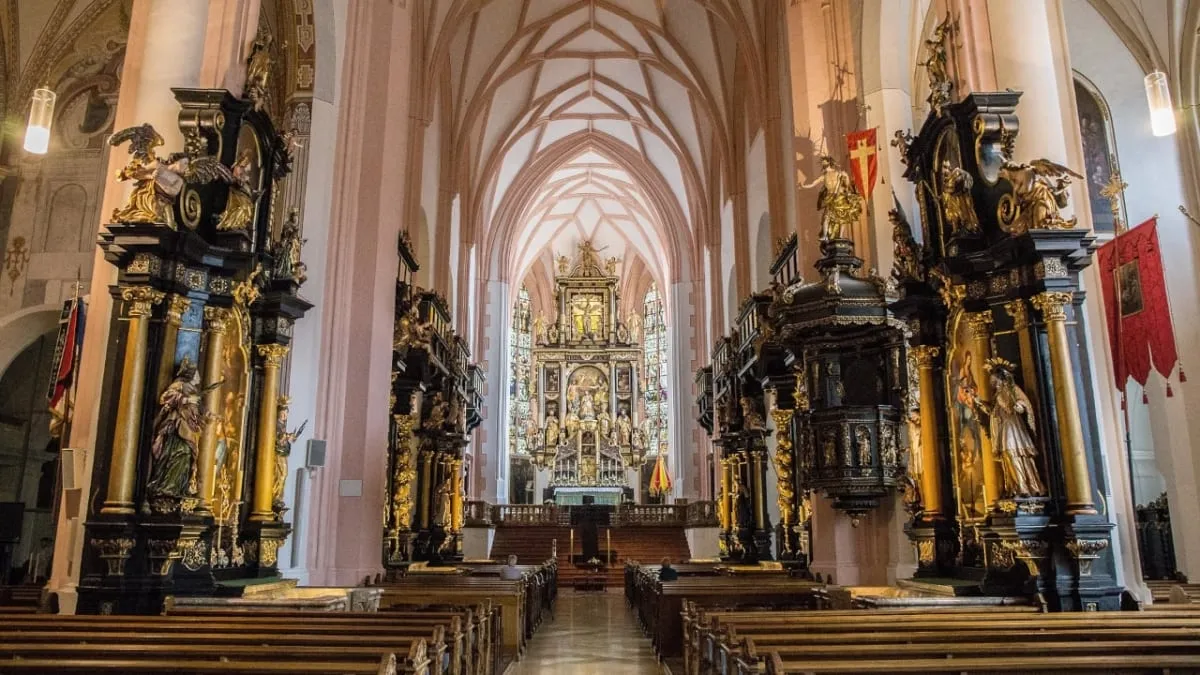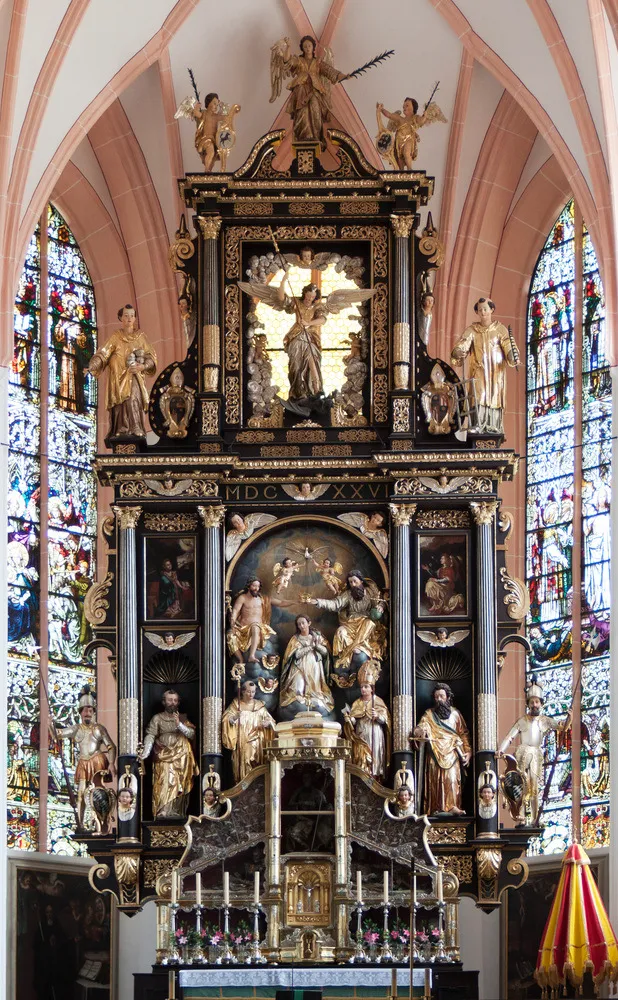Introduction

Mondsee Abbey (Kloster Mondsee) was a prominent Benedictine monastery situated in Mondsee, Upper Austria. The Abbey Church of St. Michael, which is part of the complex, now functions as the local Parish Church.
One of its most striking features is the altarpiece, designed as a magnificent reliquary that houses the jeweled skeleton of Abbot Konrad II, showcasing both artistic craftsmanship and historical significance. This unique blend of art and reverence highlights the monastery’s role in preserving religious relics. In recognition of its importance, Pope John Paul II elevated the church to basilica status in 2005, underscoring its significance as a place of worship and pilgrimage. The abbey’s rich history and architectural beauty continue to attract visitors and reflect its enduring legacy in the region.
Benedictine monastery in Mondsee in Austria. The Abbey Church of St. Michael became the Parish Church. The altarpiece is designed as a giant reliquary, containing.

The Region of the Mondseeland, in which Mondsee is located, was formerly part of Bavaria. Mondsee Abbey was founded in 748 by Odilo, Duke of Bavaria on the ruins of a Roman settlement.
According to legend, Duke Odilo was in the area with his wife and large entourage, got lost and was surprised by the night. He was at risk of falling high on a rock. But when the moon came out between the clouds, it made the water surface of the lake shine deep, which made the Duke aware of the danger. In gratitude for his salvation, Duke Odilo vowed to have a monastery built on the shores of the lake and gave the lake the name “Mondsee”.
The abbey tradition was that the first monks came from the St Peter’s abbey of Salzburg and others also from Monte Cassino in Italy. In 788, after the fall of Duke Tassilo III, Mondsee became an Imperial abbey and over the centuries acquired extensive property. Mondsee had a very active scriptorium and became an important centre for book production in Upper Austria. Around 800 the Codex Millenarius, an illustrated Latin book of the Gospels was written at the abbey. In 831 King Louis the Pious gave the monastery to Regensburg Cathedral. Wolfgang of Regensburg, Bishop of Ratisbon, spent a year at Mondsee in 976.
It was not until 1142 that it regained its independence, under Abbot Conrad II, otherwise Conrad of Mondsee. Conrad, formerly a monk of Siegburg Abbey, had been abbot of Mondsee since 1127, and was extremely successful in defending and regaining the rights and possessions of the monastery, to the extent that in 1145 he was murdered by a group of nobles at Oberwang nearby. He was venerated as a martyr and declared Blessed. Conrad was succeeded as abbot by Walter of Mondsee (died 17 May 18), long remembered as a model by the community for his exemplary striving after virtue. He was buried in St. Peter’s chapel in the abbey church.
In 1506 possession of the Mondseeland passed from Bavaria to Austria. In 1514 Abbot Wolfgang Haberl established the abbey grammar school. After a period of decline during the Reformation and the consequent disturbances, the abbey entered a new period of prosperity. Under Abbot Bernhard Lidl (1727–73) and especially in connection with the celebration of the thousandth anniversary of the foundation, there was extensive re-building of the church and the monastic premises. From 1773 the abbot was Opportunus II Dunkl, who was the last abbot of Mondsee: in 1791 the abbey was dissolved by Emperor Leopold II. Many of its manuscripts were transferred to what are today the Austrian National Library, the State Library of Upper Austria and the State Archive of Upper Austria.
From 1625 until its dissolution the abbey was a member of the Benedictine Austrian Congregation. During the Napoleonic period the Mondseeland reverted to Bavaria for a few years. During that time, in 1810, the Bavarian Field Marshal Prince Karl Philipp von Wrede acquired the abandoned monastery (along with the nearby abbeys of Suben and Gleink), and used it as a castle. Wrede remained the owner even after the return of the territory to Austria and significantly developed the locality, for example by the construction of roads and the establishment of local cheese production. In 1905, on the death of Princess Ignazia von Wrede, Mondsee passed to the Counts Almeida, whose descendants sold it in 1985.
In the 15th century, the monastery once again experienced a period of prosperity. Abbot Johannes II Trenbeck (1415-1420) took part in the Council of Constance. He is also said to be the author of a history of this council. The magnificently decorated Urbarium of 1416 was written during his tenure. His successor as Abbot Simon Reuchlin (1420-1463) introduced the reform originating from Melk Abbey. As a result, almost all the churches in the Mondsee region were rebuilt and new monastery buildings were erected. The chapter house was built in 1444 and the cloister in 1448.
Abbot Benedikt Eck (1463-1499) had the present late Gothic church built under master builder Hans Lenngdörffer from Burghausen. The consecration of the nave was celebrated in 1487. Abbot Wolfgang Haberl (1499-1521) had the High Cross Chapel built for pilgrims. He also founded the first monastery grammar school in Upper Austria in Mondsee in 1514, which existed until the monastery was dissolved.

In 1626, the Salzburg sculptor Hans Waldburger designed the early Baroque high altar, which is up to 18 metres high. It was Abbot Coelestin Kolb (1668-1683) who brought Meinrad Guggenbichler (born in Einsiedeln in 1649) to Mondsee. He worked in Mondsee from 1679 until his death in 1723.
He created the following altars for the monastery church: the Holy Spirit Altar, the Wolfgang Altar, the Corpus Christi Altar, the Poor Souls Altar, the Sebastian Altar, the Altar of the Virgin Mary and the Altar of St Peter. The pulpit and the organ case also originate from his artistic endeavours. Under Abbot Coelestin, the church interior was greatly altered. The rood screen (separating the chancel from the rest of the church) was removed. Low baroque chapels with groined vaults were built in the north and south aisles.
Later, the Tyrolean Franz Anton Koch (1700-1756) added further altars: the altar of St John, the altar of St Joseph, the altar of St Anne or the Virgin Mary and the altar of St Anthony. The altar of the cross was created by the Mondsee sculptor Leopold Schindlauer. The 1000th anniversary celebrations took place during the tenure of Abbot Bernhard Lidl (1729-1773). He took this as an opportunity to erect the four-axis, four-storey double-tower façade.
The towers are 52 metres high today. The figures of St Peter and St Paul can be found in the façade. The abbot himself wrote an extensive history (Chronicon Lunaelacense) of the monastery from its beginnings. After the market fire of 1774, which also destroyed the church roof, the monastery roofs in the south were replaced by the current mansard roof.
After the death of Abbot Opportunus (1773-1784), the election of a new abbot was forbidden and an administrator was appointed. In 1791, Mondsee Monastery, the oldest monastery on Austrian soil at the time, was abolished. The bishop of the newly founded diocese of Linz received the monastery property as an endowment. In 1809, Emperor Napoleon gave the monastery and its estates to the Bavarian field marshal Karl Philipp von Wrede. His descendants owned it as a “castle” and “Mondsee estate” until it was sold in 1986.
In 2005, the former monastery church was elevated to the status of a minor basilica under Pope John Paul II. In 2005, a three-year renovation of the church interior began, during which the interior shell of the church was completely renovated. All altars, pictures, floors in the chancels and banners were also subjected to a thorough inspection, cleaning, conservation and necessary restoration work.
The east side of the church appears to have a double choir. On its north side, the church is connected to the former monastery (now a castle). The three-nave basilica church is one of the most outstanding and largest architectural monuments in Austria (70 metres long, 34 metres wide and 22 metres high). Integrated into the church building are the former treasury (now sacristy) of the monastery, the monks’ prayer choir and the 36 metre long Gothic monastery library, which was once a medieval lectern library. The former prayer choir and the library are currently part of the Mondseeland Museum.
The Church Altar

The most famous “resident” of this relic-filled altarpiece, the skeleton of Abbot Konrad II, was actually hidden from view by a statue during the filming of the wedding scene. Never fear though, since you can visit the famous Mondsee Abbey Church in person and see these decorated skeletons and other relics in person. The insanely ornate seven-part altar is designed as a giant reliquary, holding entire skeletons for all to see. Konrad was killed in 1145 defending the monastery from noblemen who wished to repossess the land. His jewel-encrusted skeleton now sits with a golden halo a top the altar.
Konrad is not alone in the gilded altar either. Entombed beneath him are the remains of four so-called “catacomb saints,” lying in relaxed poses upon red satin pillows in their little triangular chambers. In addition to the massive, main altar there also a series of smaller altars lining the chapel walls. While these do not hold such grim relics, but they are decorated with lovely paintings.
The abbey is one of the oldest in Austria, and certainly one of the most picturesque. Whether you are into musicals, lovely churches, or jewled skeletons this alter has you cover.
Feast Day
Feast day : 29th September
The feast day of St. Michael, celebrated on September 29. This day honors the archangel Michael and is marked by special liturgical events and celebrations within the basilica, reflecting its importance in the local community and the broader Catholic tradition.
Church Mass Timing
Monday to Saturday : 6:30 pm
Sunday : 10:00 am
Church Opening Time:
Monday : 9:00 am – 7:00 pm
Tuesday : 9:00 am – 7:00 pm
Wednesday : 9:00 am – 7:00 pm
Thursday : 9:00 am – 7:00 pm
Friday : 9:00 am – 7:00 pm
Saturday : 9:00 am – 7:00 pm
Sunday : 9:00 am – 7:00 pm
Contact Info
Address:
Wredepl. 3, 5310 Mondsee, Austria
Phone: +43 6232 4166
Accommodations
Connectivities
Airway
Salzburg(SZG)Airport to Basilica of St. Michael, Mondsee distance 30 min (34.8 km) via A1.
Railway
Salzburg Hauptbahnhof to Basilica of St. Michael, Mondsee, Austria distance 27 min (28.5 km) via A1








